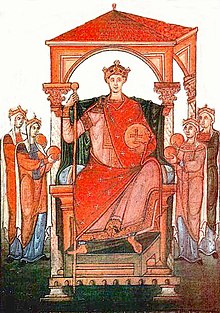Otto II, Holy Roman Emperor
| Otto II | |
|---|---|
 |
|
| Holy Roman Emperor | |
| Reign | May 7, 973 – December 7, 983 |
| Predecessor | Otto I |
| Successor | Otto III |
| King of Italy | |
| Reign | December 25, 980 – December 7, 983 |
| Predecessor | Otto I |
| Successor | Otto III |
| King of Germany | |
| Reign | May 26, 961 – December 7, 983 |
| Predecessor | Otto I |
| Successor | Otto III |
| Born | 955 Saxony, Kingdom of Germany |
| Died | December 7, 983 (aged 28) Rome, Holy Roman Empire |
| Burial | St. Peter's Basilica |
| Spouse | Theophanu |
| Issue |
Adelheid I, Abbess of Quedlinburg Sophie I, Abbess of Gandersheim Matilda, Countess Palatine of Lotharingia Otto III, Holy Roman Emperor |
| House | Ottonian |
| Father | Otto the Great |
| Mother | Adelaide of Italy |
| Religion | Roman Catholic |
| German royal dynasties | |||
| Ottonian dynasty | |||
| Chronology | |||
| Henry I | 919 – 936 | ||
| Otto I | 936 – 973 | ||
| Otto II | 973 – 983 | ||
| Otto III | 983 – 1002 | ||
| Henry II | 1002 – 1024 | ||
| Family | |||
|
Family tree of the German monarchs |
|||
| Succession | |||
|
Preceded by Conradine dynasty |
Followed by Salian dynasty |
||
Otto II (955 – December 7, 983), called the Red (Rufus), was Holy Roman Emperor from 973 until his death in 983. A member of the Ottonian dynasty, Otto II was the youngest and sole surviving son of Otto the Great and Adelaide of Italy.
Otto II was made joint-ruler of Germany in 961, at an early age, and his father named him co-Emperor in 967 to secure his succession to the throne. His father also arranged for Otto II to marry the Byzantine Princess Theophanu, who would be his wife until his death. When his father died after a 37-year reign, the eighteen-year-old Otto II became of the Holy Roman Empire in a peaceful succession. Otto II spent his reign continuing his father's policy of strengthening Imperial rule in Germany and extending the borders of the Empire deeper into southern Italy. Otto II also continued the work of Otto I in subordinating the Catholic Church to Imperial control.
Early in his reign, Otto II defeated a major revolt against his rule from other members of the Ottonian dynasty who claimed the throne for themselves. His victory allowed him to exclude the Bavarian line of Ottonians from the line of Imperial succession. This strengthened his authority as Emperor and secured the succession of his own son to the Imperial throne.
With domestic affairs settled, Otto II would focus his attention from 980 onward to annexing the whole of Italy into the Empire. His conquests brought him into conflict with the Byzantine Empire and with the Muslims of the Fatimid Caliphate, who both held territories in southern Italy. After initial successes in unifying the southern Lombard principalities under his authority and in conquering Byzantine-controlled territory, Otto II's campaigns in southern Italy ended in 982 following a disastrous defeat by the Muslims. While he was preparing to counterattack Muslim forces, a major uprising by the Slavs broke out in 983, forcing the Empire to abandon its major territorial holdings east of the Elbe river.
...
Wikipedia
